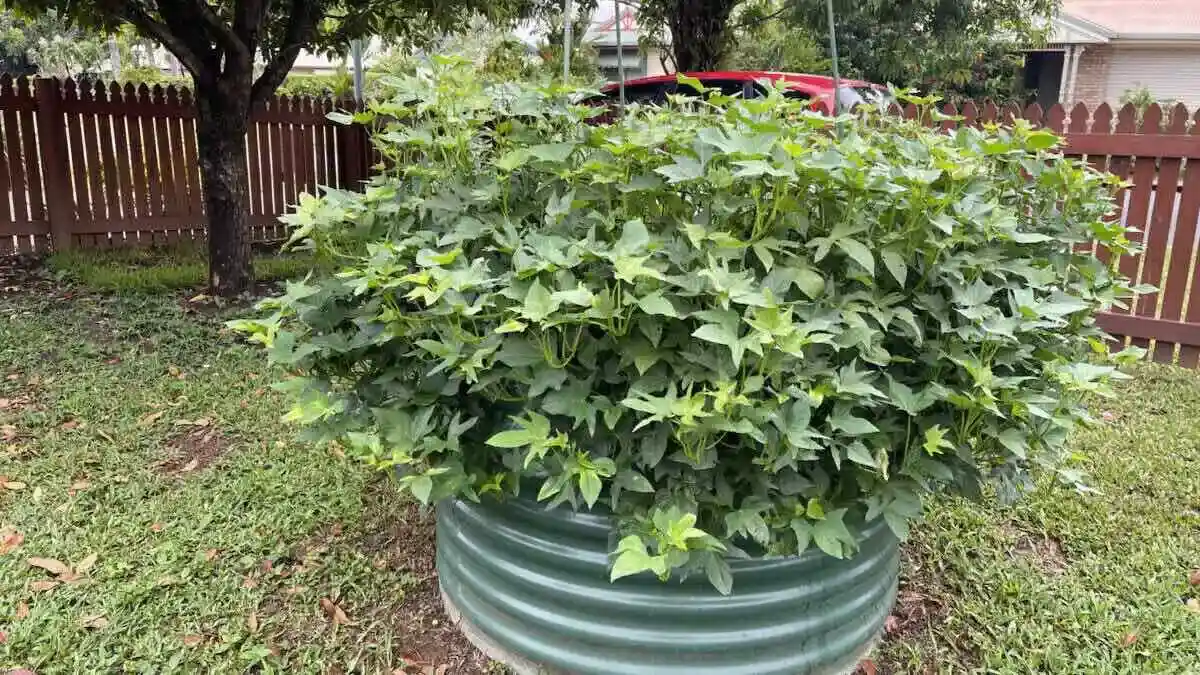Table of contents
Sweet Potato Growing
Sweet potato growing tips make growing this starchy, sweet-tasting, tuber easy. It is already one of the easiest vegetables to grow in the tropics. Sweet potato (Ipomoea batatas) belongs to the bindweed or morning glory family of plant.
Cultivars of the sweet potato have been bred to bear tubers with flesh and skin of various colours. However, darker coloured sweet potatoes are referred to as ‘yams’ in much of North America.
Sweet Potato Growing Season
In Australia, sweet potatoes generally thrive in warm climates and are typically grown in the warmer months of spring and summer. The ideal growing conditions for sweet potatoes include warm soil temperatures (around 21-26°C) and plenty of sunlight.
Here’s a general guide to the growing season for sweet potatoes in different regions of Australia:
- Northern Australia (tropics):
- Sweet potatoes can be planted any time of year in the tropics, as it is always warm enough to grow sweet potato here.
- Northern Australia (sub-tropics):
- Sweet potatoes can be planted from September to November, as these regions have an earlier start to warm weather.
- Eastern Australia (New South Wales, Victoria):
- In these states, sweet potatoes are usually planted from October to December.
- Western Australia:
- The planting season typically starts a bit later, from October to January.
- Southern Australia (South Australia, Tasmania):
- Sweet potatoes can be planted from November to January in these cooler regions, ensuring they are grown during the warmer part of the year.
It’s important to note that these are general guidelines, and specific planting times may vary depending on local climate conditions and frost dates. Sweet potatoes require a relatively long growing season (around 5 months) to mature fully, so planting should be timed to ensure they have enough warm days to develop properly before the weather cools down again.
Sweet Potato Growing Conditions
In the tropics it is not hard to find the perfect growing conditions for sweet potatoes.
Location and Soil
Sweet potato grows unbelievably well in the tropics. If the paw paw is our pick for the ‘easy to grow fruit’ in the tropics, then the sweet potato is the ‘easy to grow vegetable’. Once planted it is almost unstoppable!
One of our key sweet potato growing tips is to use crumbly loose soil that has organic material in it. This is by far the best home for this tropical vegetable. In contrast, boggy water-logged soil should be avoided, as any tubers that grow there could rot.
Sweet Potato Growing Tips
Time needed: 4 minutes
How to grow sweet potatoes from slips.
- Preparation
Select a location for your sweet potato. Make sure you have enough space for a sprawling vine. Make sure the area is in full sun and drains well.
- Planting
Place all your cuttings and existing vine where you want to grow your new crop.
- Cover
Cover the vine with a thin layer (at least 5cm or 2in) of compost and/or well rotted manure. If you only have dirt to cover it, you can add some blood and bone to give it a kick start.
- Water and Wait
Water if it is dry or let a tropical downpour do it for you. New shoots will emerge from the soil after a few days.
- Harvest
After 5 – 6 months, you should be able to dig up your sweet potato tubers.
How to Grow Sweet Potatoes from a Sweet Potato
You can buy a tuber from the shop and plant it in your garden. All being well it should grow into a healthy vine.
How Deep do Sweet Potatoes Grow?
We plant our cuttings around 7.5cm (3in) deep (and 20cm or 8in apart).
When you harvest, be sure to dig down at least a foot (30cm) as you will be surprised how deep some of the new tubers may be.
Sweet Potato Growing in Pots
Sweet potato is more easy to grow direct in the ground than many other vegetables. However, we still recommend growing in pots or containers. Pots drain well and allow you to better control your growing medium.
Fertilising Sweet Potato
When using a good growing medium, I find that you don’t need much fertiliser. So after harvesting, I simply gather the old vine and place it in the chosen location and cover it with sheep manure. Likewise, you could loosely cover the old vine with soil and sprinkle some blood and bone on the top and water in.
That should be all the fertilising that is needed until the next harvest time in 5 to 6 months.
Watering
Once they are established, sweet potatoes do not need a lot of water to survive. However, it is best to keep the planted area moist with one inch of water once a week. One should not water in the last three weeks before harvesting. Stopping water helps to prevent the tubers from splitting.
Sweet Potato Growing Tips for Pests and Disease
Many pests can reduce the quality and yield of your crop. However, soil insect pests that damage the roots directly are the most troublesome pests.
Foliage feeding insects can harm the plants indirectly, but usually only at very high numbers. Personally, I am happy to share my leaves with a few bugs, as there is always more than enough foliage for both of us.
Sweet Potato Weevil
The biggest enemy of growers is the sweet potato weevil. The adult weevil attacks both the vines and the tubers. Consequently, this weevil is a great cause of crop loss in developing countries.
Sweet Potato Root Knot Nematode
The sweet potato root knot nematode is the major nematode pest in the tropics. Consequently, this pest attacks fibres and roots, allowing other pathogens to penetrate the plant through the wounds.
Whiteflies
Whiteflies are common pests of many plants. However, the species, Bemisia tabaci, is a particularly serious pest of sweet potato.
White oil sprays can bring the whiteflies under control. You must spray the underside of leaves and buds, because this is where the whiteflies congregate. Also remember it is best to spray after 5pm to reduce the chance of leaves getting sunburnt.
- White oil:
- 3 tablespoons (1/3 cup) cooking oil in 4 litres water.
- ½ teaspoon detergent soap.
- Shake well and use.
Another organic spray you can use is Neem oil. Made from the fruit and seeds of the Neem tree, it is a great organic way to keep pests at bay.
Sweet potato growing season Australia
Growing Sweet Potatoes in NSW Australia
In New South Wales and Victoria sweet potatoes are usually planted from October to December. Specific planting times may vary depending on local climate conditions and frost dates.
Sweet potatoes require a relatively long growing season (around 5 months) to mature fully, so planting should be timed to ensure they have enough warm days to develop properly before the weather cools down again.
Growing Sweet Potatoes in Canberra
This situation in Canberra is the same as NSW and Victoria, but you can consider starting your plant off inside in October for a March harvest.
Sweet Potato Seeds Bunnings
Sweet potatoes aren’t started by seed like most other vegetables, they’re started from slips. Slips are shoots grown from a mature sweet potato. Learn how to grow and when to harvest sweet potatoes and also how to cure your sweet potatoes after the harvest.
Eating Sweet Potato
The young leaves can be plucked from the vine and eaten as greens. Indeed they are a great addition to a home-made salad.
Once, you have scrubbed clean your tubers they can be eaten with or without the skin. You can eat the tubers steamed, mashed or roasted or indeed in stews or salads. As a consequence you can find many recipes online.
Health Benefits
It’s rich in the antioxidant beta carotene, which is effective in raising blood levels of vitamin A, particularly in children.
Blood Pressure
You should avoid foods that contain high amounts of added salt. Instead, consume more potassium-rich foods to maintain a healthy cardiovascular system. Indeed, sweet potato is a good source of potassium and can assist in reducing blood pressure.
Antioxidants
Antioxidants such as beta-carotene can help prevent cellular damage caused by free radicals. Indeed if levels of free radicals in the body get too high, cellular damage can occur, which increases the risk of some conditions.
Fibre
Sweet potatoes contain fibre that is essential to gut health and in helping to prevent constipation. This can also reduce chances of colorectal cancers.
In conclusion, this healthy and easy to grow vegetable is a great addition to any tropical garden.
Other Tropical Vegetables
- Capsicum
- Cucumber
- Eggplant
- Jicama
- Kangkong
- Malabar Spinach
- Pak Choi
- Perpetual Spinach
- Pumpkin Growing
- Snake Beans
- Tatsoi




Comments
One response to “Sweet Potato Growing Guide”
[…] Sweet Potato […]